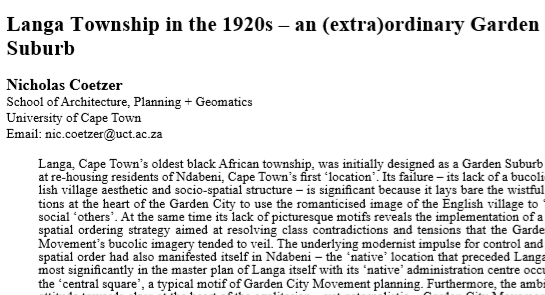Langa Township in the 1920s
An (extra)ordinary Garden Suburb

Langa, Cape Town’s oldest black African township, was initially designed as a Garden Suburb aimed at re-housing residents of Ndabeni, Cape Town’s first‘location’.Its failure–itslackofabucolicEnglish village aesthetic and socio-spatial structure – is significant because it lays bare the wistful ambitions at the heart of the Garden City to use the romanticised image of the English village to ‘uplift’ social ‘others’. At the same time, its lack of picturesque motifs reveals the implementation of a socio-spatial ordering strategy aimed at resolving class contradictions and tensions that the Garden City Movement’s bucolic imagery tended to veil. The underlying modernist impulse for control and sociospatial order had also manifested itself in Ndabeni – the ‘native’ location that preceded Langa – but most significantly in the master plan of Langa itself with its ‘native’ administration centre occupying the ‘central square’, a typical motif of Garden City Movement planning. Furthermore, the ambivalent attitude towards a class at the heart of the egalitarian – yet paternalistic – Garden City Movement, and, the difficulty the colonial administrators and architects had in defining and categorising black Africans in the city of Cape Town, is also apparent in the various types of accommodation that were imagined and implemented at Langa. The colonial context of Langa, thus, defines it as an extraordinary garden Suburb, and yet, in its clear manifestation of social-spatial order – stripped bare of bucolic imagery – it can be understood essentially as an ‘ordinary’ Garden Suburb.


Comments